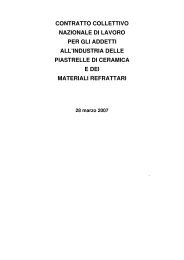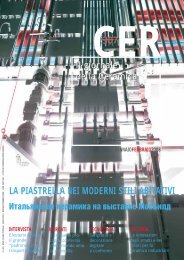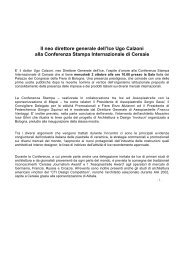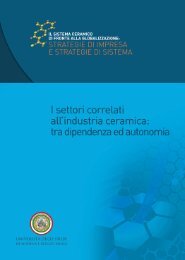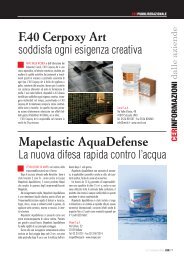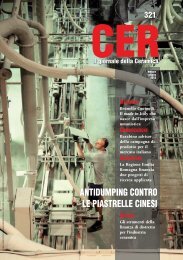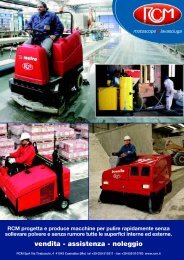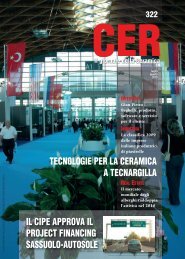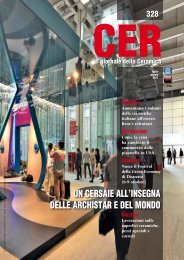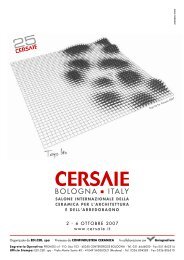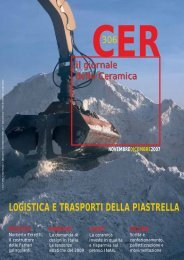Cer_318_completo xweb.pdf - Confindustria Ceramica
Cer_318_completo xweb.pdf - Confindustria Ceramica
Cer_318_completo xweb.pdf - Confindustria Ceramica
You also want an ePaper? Increase the reach of your titles
YUMPU automatically turns print PDFs into web optimized ePapers that Google loves.
SACMI IMOLA<br />
Via Provinciale Selice 17/A - 40026 Imola (BO)<br />
Tel 0542 607111 - Fax 0542 642354<br />
www.sacmi.com - sacmi@sacmi.it<br />
H.E.R.O. - High Efficiency Resourse Optimizer<br />
La minore disponibilità delle fonti energetiche tradizionali,<br />
con il conseguente aumento dei loro costi, rende oggi vitale<br />
per lo sviluppo strategico delle aziende individuare la<br />
migliore gestione dei processi produttivi e ottimizzare l’utilizzo<br />
delle risorse. Per rispondere con efficacia a questa crescente<br />
esigenza a livello ambientale ed economico, Sacmi<br />
ha fondato H.E.R.O. - High Efficiency Resource Optimizer,<br />
un laboratorio di studi e ricerca dedicato allo sviluppo di<br />
tecnologie innovative volte al massimo risparmio delle<br />
risorse in tutte le fasi dei processi di produzione. Le applicazioni<br />
speciali sviluppate all’interno del progetto H.E.R.O.<br />
permettono un contenimento medio dei consumi energetici<br />
delle macchine principali dell’impianto di oltre il 20%, nell’ottica<br />
di un più attento energy management. I vantaggi<br />
economici si riflettono così sul conto profitti dell’impresa<br />
già dal primo anno di applicazione, all’interno di una strategia<br />
che rispetta l’ambiente ed eleva costantemente gli<br />
standard qualitativi. Con particolare riferimento al processo<br />
di cottura delle piastrelle, Sacmi propone:<br />
• sistema BSR (aria comburente basso-riscaldata). L’aria di<br />
combustione passa attraverso uno scambiatore di calore<br />
posto nel raffreddamento rapido prima di essere inviata ai<br />
bruciatori ad una temperatura di circa 100°C. Sottraendo<br />
calore al raffreddamento rapido, lo scambiatore consente<br />
anche di diminuire la quantità di volumi necessari per il<br />
raffreddamento del materiale. La riduzione del consumo<br />
specifico rispetto al funzionamento ad aria fredda è dell’ordine<br />
del 5%;<br />
• sistema MDR (aria comburente medio-riscaldata). Al fine<br />
di consentire un ulteriore risparmio energetico rispetto al<br />
sistema BSR, è possibile modificare il sistema di raffreddamento<br />
finale del forno. I volumi di aria raccolti dal raffreddamento<br />
lento e finale ed evacuati dal camino ad una<br />
temperatura di 100-120°C vengono intercettati, mandati<br />
allo scambiatore di calore nel raffreddamento rapido e<br />
quindi utilizzati come aria comburente ad una temperatura<br />
di 170°C circa. Si ritiene che l’incremento del risparmio<br />
energetico possa essere dell’ordine di un 5% in più rispetto<br />
al valore di consumo ottenibile con l’installazione del<br />
solo scambiatore;<br />
• sistema SPR (aria comburente super-riscaldata). Per ottenere<br />
un ulteriore risparmio energetico rispetto al sistema<br />
MDR, è possibile sdoppiare i camini di espulsione aria nel<br />
raffreddamento lento e finale del forno. La temperatura<br />
dell’aria di combustione viene innalzata fino ad un max di<br />
220°C circa. Si ritiene possibile un incremento del risparmio<br />
energetico dell’ordine di un 5% in più rispetto al valore<br />
di consumo ottenibile con l’installazione del sistema<br />
MDR. Con il sistema di preriscaldo dell’aria di combustione<br />
SPR, il risparmio sul combustibile si attesta attorno al 15%.<br />
CERGALLERIA Essiccamento e cottura<br />
H.E.R.O. - High Efficiency Resourse Optimizer<br />
The reduced availability of traditional energy sources and<br />
the resulting increase in their cost now make it vital, for<br />
the strategic development of companies, to identify the<br />
best way of managing production processes and<br />
optimising the use of resources. To meet this growing<br />
need effectively, in both environmental and economic<br />
terms, SACMI founded H.E.R.O., High Efficiency Resource<br />
Optimiser. This study and research laboratory is<br />
dedicated to developing innovative technologies for<br />
achieving the greatest possible resource savings in every<br />
phase of the production process. The special applications<br />
developed as part of the H.E.R.O. project enable the<br />
energy consumption of the main machine in the<br />
installation to be reduced by more than 20% on average,<br />
with a view to more careful energy management. The<br />
economic benefits are therefore reflected in the<br />
company’s profits right from the first year of application,<br />
as part of a strategy of respect for the environment and<br />
constant raising of quality standards. In details, as regards<br />
the firing process, Sacmi offers:<br />
• BSR system (low-heated combustion air). The combustion<br />
air passes through a heat exchanger located in the rapid<br />
cooling zone before being sent to the burners at a temperature<br />
of approximately 100°C. Removing heat from the rapid<br />
cooling zone, the exchanger also decreases the volumes<br />
needed to cool the material. The energy savings compared<br />
to cold air operation is in the order of 5%;<br />
• MDR system (medium-heated combustion air). In order to<br />
obtain further energy savings with respect to the BSR system,<br />
the kiln’s final cooling system can be modified. The volumes<br />
of air collected by slow and final cooling and evacuated<br />
from the chimney at a temperature of 100-120°C are<br />
intercepted, sent to the heat exchanger in the rapid cooling<br />
zone and then used as combustion air at a temperature of<br />
approximately 170°C. It is believed that the increase in energy<br />
savings can be in the order of 5% more than the consumption<br />
value achievable by installing the exchanger only;<br />
• SPR system (super-heated combustion air). To obtain additional<br />
energy savings with respect to the MDR system, it is<br />
possible to duplicate the air expulsion chimneys in the kiln’s<br />
slow and final cooling zones. The combustion air temperature<br />
is raised to a maximum of approximately 220°C. It is<br />
believed that the increase in energy savings can be in the<br />
order of 5% more than the savings achievable by installing<br />
the MDR system. With the SPR combustion air preheating<br />
system, the fuel saving is around 15%.<br />
2009 novembre/dicembre CER 89



